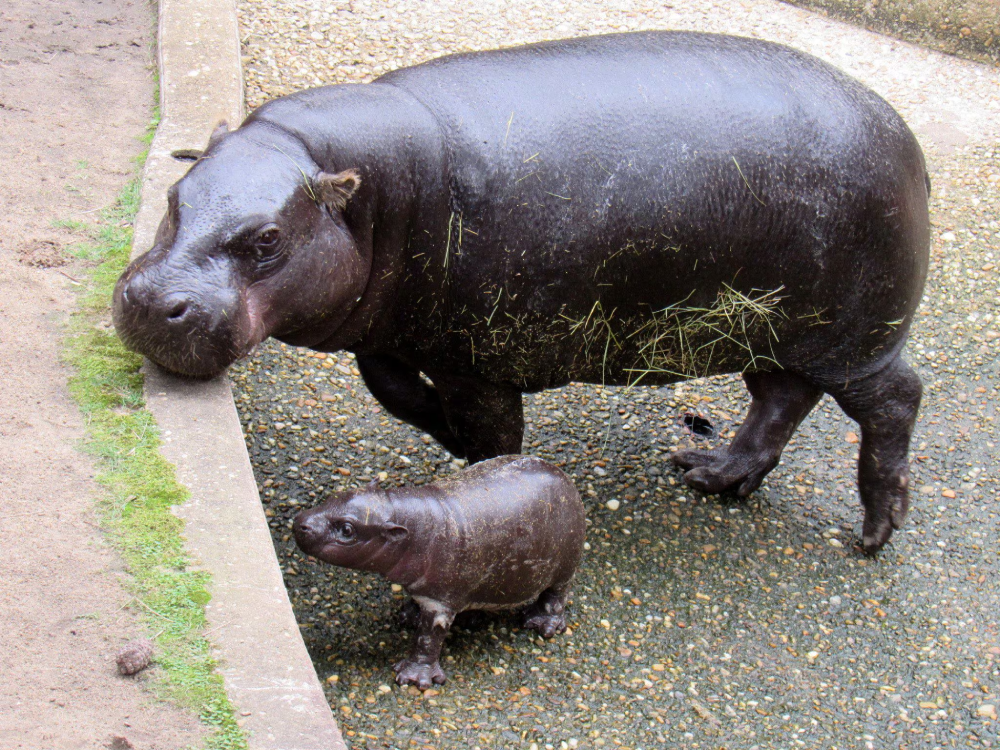In the dense rainforests and swampy habitats of West Africa lurks a creature both enigmatic and adorable: the Pygmy Hippopotamus (*Hexaprotodon liberiensis*). While its larger cousin, the common hippopotamus, often steals the spotlight, the Pygmy Hippo holds its own as one of the most fascinating and lesser-known species in the animal kingdom.
Origins and Evolution of Pygmy Hippopotamus
The Pygmy Hippopotamus is a relic of ancient times, with roots tracing back millions of years to the Miocene epoch. Fossil evidence suggests that its ancestors roamed not only Africa but also parts of Europe and Asia. However, as climates changed and habitats evolved, the Pygmy Hippo gradually retreated into the secluded rainforests and riverine areas of West Africa, primarily in Liberia, Ivory Coast, Sierra Leone, and Guinea.
Distinctive Features
Despite its diminutive stature compared to its larger relative, the Pygmy Hippo is no less remarkable. Standing at about 75-85 centimeters (30-34 inches) tall at the shoulder and weighing between 180 and 275 kilograms (400-600 pounds), it possesses a compact yet robust build ideally suited for navigating its dense, swampy habitat. Its dark brown to purplish-gray skin is hairless and slick, providing protection against waterborne parasites and allowing for efficient movement through aquatic environments.
One of the most striking features of the Pygmy Hippo is its disproportionately large head, adorned with small, rounded ears and beady eyes positioned high on its skull. Its nostrils and eyes are on the top of its head, enabling the animal to remain submerged while still being able to breathe and observe its surroundings. Additionally, the Pygmy Hippo’s jaws house formidable tusks, although they are smaller and less prominent than those of its larger cousin.
Habitat and Behavior of the Pygmy Hippopotamus
The Pygmy Hippopotamus is primarily nocturnal, spending its days nestled in the dense vegetation along riverbanks and emerging under the cover of darkness to forage for food. Its semi-aquatic lifestyle is facilitated by its webbed feet, which allow it to move effortlessly through the water, and its ability to hold its breath for several minutes at a time. Despite its solitary nature, Pygmy Hippos are not entirely antisocial and have been observed engaging in vocalizations, especially during mating rituals and territorial disputes.
Their diet consists mainly of grasses, leaves, fruits, and aquatic plants, which they graze on both land and in the water. Unlike their larger counterparts, Pygmy Hippos do not engage in territorial defecation and instead scatter their feces randomly, a behavior that may be linked to their elusive nature and preference for privacy.
Conservation Status and Threats
While the Pygmy Hippopotamus may seem like a creature untouched by the troubles of the modern world, it faces numerous threats to its survival. Habitat loss due to deforestation, agricultural expansion, and human encroachment poses a significant risk to Pygmy Hippo populations, fragmenting their already limited range and reducing their access to vital resources.
Furthermore, the Pygmy Hippo is a sought-after target for poachers due to the illegal wildlife trade, with its meat, skin, and body parts fetching high prices on the black market. Despite legal protections in place across its range, enforcement remains lax, allowing poaching to persist unchecked.

Conservation Efforts of Pygmy Hippopotamus
Recognizing the urgent need to safeguard this unique species, conservation organizations and government agencies have implemented various initiatives aimed at protecting the Pygmy Hippopotamus and its habitat. These efforts include establishing protected areas, conducting research on population dynamics and behavior, and raising awareness among local communities about the importance of conserving their natural heritage.
One such success story is the Tai National Park in Ivory Coast, which harbors a significant population of Pygmy Hippos within its borders. Through rigorous monitoring and anti-poaching measures, authorities have managed to stabilize Pygmy Hippo numbers in the park, providing hope for the species’ long-term survival.
Conclusion
In a world dominated by larger, more iconic species, the Pygmy Hippopotamus stands as a testament to the diversity and adaptability of life on Earth. Despite facing numerous challenges, from habitat loss to poaching, this enigmatic creature continues to endure, reminding us of the importance of conservation efforts in preserving our planet’s natural heritage.
As we strive to protect and conserve the Pygmy Hippopotamus and other endangered species, we not only safeguard their future but also enrich our own lives by ensuring that future generations can continue to marvel at the wonders of the natural world.









